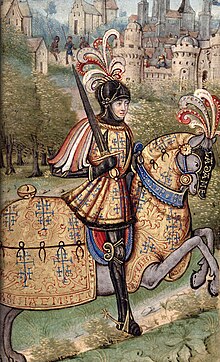René II (Lorraine)

René II. , Also Renatus II. (* May 2, 1451 in Angers ; † December 10, 1508 in Fains ), from the House of Vaudémont , had been Duke of Lorraine since 1473 . Its historical significance is based primarily on its ultimately successful resistance against Charles the Bold of Burgundy.
biography
René was the son of Ferry II. De Vaudémont and Yolande d'Anjou and a grandson of René d'Anjou . He spent his youth at the grandfather's court. René received an excellent education and was interested in art, literature and science.
As early as 1470 he had become Count of Vaudémont , in 1472 Baron von Elbeuf and in 1480 he also received the title of Duke of Bar . In 1473 his cousin Nicolas d'Anjou , the former Duke of Lorraine, died. The duchy passed to his aunt, René's mother, who immediately passed it on to her son.
In the course of the Burgundian Wars , Lorraine got between the fronts of the conflict between the French King Louis XI. and the Burgundian Duke Charles the Bold . René initially leaned towards the Burgundian side, but changed sides in 1474 and made a secret pact with the king. After he was initially defeated and had to evacuate Lorraine, he succeeded on January 5, 1477 together with federal troops in the battle of Nancy , to defeat Charles the Bold, who was killed in the battle. René formed a coalition after the death of Louis XI. with a number of French princes in the guerre folle against the ruling royal house of Valois, represented at this time by Anne de Beaujeu , who reigned for the underage Charles VIII . In 1488 he claimed the crown of Naples and the county of Provence as Duke of Calabria and Titular King of Jerusalem .
Like his grandfather Renatus von Anjou , he was a German imperial prince . He attended the Diet of Worms in 1495 to receive his fiefdom from the ruling Roman-German King Maximilian .
In 1504 he finally became Count of Guise . He fell ill while hunting and died at the age of 57. His son Anton II succeeded him in 1509.
Cartographic interests
It is believed that the Duke had a keen interest in cartography. Instead of accepting money for various things, he was given services in the form of cards from the various seafarers of his time. It is believed that he provided the information on the basis of which Martin Waldseemüller and Matthias Ringmann created a very early and yet very precise map of the world around 1507.
Marriages and offspring
From 1471 he was married to Jeanne d'Harcourt, the Countess of Tancarville . He disowned her because she could not give birth to any offspring and married Philippa von Geldern on September 1, 1485 . With her he had twelve children, five of whom reached adulthood and became influential figures of their time.
- Anton (1489–1544), who succeeded him as Duke of Lorraine
- Claude (1496–1550), Duke of Guise
- Jean (1498–1550), cardinal, archbishop of Reims, Lyon and Narbonne and bishop of several dioceses
- Louis (1500–1528), Bishop of Verdun
- François (1506–1525), Count of Lambesc
literature
- Wilhelm Wiegand: René II of Lorraine . In: Allgemeine Deutsche Biographie (ADB). Volume 28, Duncker & Humblot, Leipzig 1889, pp. 209-211.
Web links
Remarks
- ↑ All children are listed in the article Philippa von Geldern .
| predecessor | government office | successor |
|---|---|---|
| Nicholas I. |
Duke of Lorraine (with Jolande until 1483 ) 1473–1508 |
Anton II |
| personal data | |
|---|---|
| SURNAME | René II. |
| ALTERNATIVE NAMES | René II of Lorraine |
| BRIEF DESCRIPTION | Duke of Lorraine (1473–1508) |
| BIRTH DATE | May 2, 1451 |
| PLACE OF BIRTH | Angers |
| DATE OF DEATH | December 10, 1508 |
| PLACE OF DEATH | Fains |
